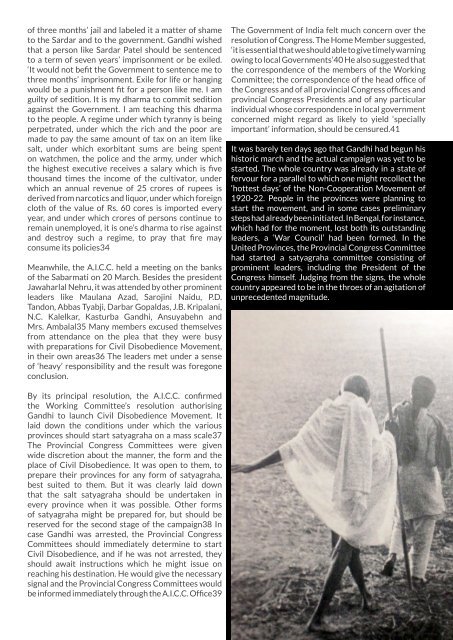Wishesh June 2015 Online E-Magazine
Politics Cover Page of NarendraModi and Special Story with NarendraModi Of One Year Government.Wisheseh Magazine, Online E-Magazine, Cinesprint Online Entertainment Magazine, PoliticalNews, Politics, HealthTips, Yoga, NarendraModi
Politics Cover Page of NarendraModi and Special Story with NarendraModi Of One Year Government.Wisheseh Magazine, Online E-Magazine, Cinesprint Online Entertainment Magazine, PoliticalNews, Politics, HealthTips, Yoga, NarendraModi
You also want an ePaper? Increase the reach of your titles
YUMPU automatically turns print PDFs into web optimized ePapers that Google loves.
of three months’ jail and labeled it a matter of shame<br />
to the Sardar and to the government. Gandhi wished<br />
that a person like Sardar Patel should be sentenced<br />
to a term of seven years’ imprisonment or be exiled.<br />
‘It would not befit the Government to sentence me to<br />
three months’ imprisonment. Exile for life or hanging<br />
would be a punishment fit for a person like me. I am<br />
guilty of sedition. It is my dharma to commit sedition<br />
against the Government. I am teaching this dharma<br />
to the people. A regime under which tyranny is being<br />
perpetrated, under which the rich and the poor are<br />
made to pay the same amount of tax on an item like<br />
salt, under which exorbitant sums are being spent<br />
on watchmen, the police and the army, under which<br />
the highest executive receives a salary which is five<br />
thousand times the income of the cultivator, under<br />
which an annual revenue of 25 crores of rupees is<br />
derived from narcotics and liquor, under which foreign<br />
cloth of the value of Rs. 60 cores is imported every<br />
year, and under which crores of persons continue to<br />
remain unemployed, it is one’s dharma to rise against<br />
and destroy such a regime, to pray that fire may<br />
consume its policies34<br />
Meanwhile, the A.I.C.C. held a meeting on the banks<br />
of the Sabarmati on 20 March. Besides the president<br />
Jawaharlal Nehru, it was attended by other prominent<br />
leaders like Maulana Azad, Sarojini Naidu, P.D.<br />
Tandon, Abbas Tyabji, Darbar Gopaldas, J.B. Kripalani,<br />
N.C. Kalelkar, Kasturba Gandhi, Ansuyabehn and<br />
Mrs. Ambalal35 Many members excused themselves<br />
from attendance on the plea that they were busy<br />
with preparations for Civil Disobedience Movement,<br />
in their own areas36 The leaders met under a sense<br />
of ‘heavy’ responsibility and the result was foregone<br />
conclusion.<br />
The Government of India felt much concern over the<br />
resolution of Congress. The Home Member suggested,<br />
‘it is essential that we should able to give timely warning<br />
owing to local Governments’40 He also suggested that<br />
the correspondence of the members of the Working<br />
Committee; the correspondence of the head office of<br />
the Congress and of all provincial Congress offices and<br />
provincial Congress Presidents and of any particular<br />
individual whose correspondence in local government<br />
concerned might regard as likely to yield ‘specially<br />
important’ information, should be censured.41<br />
It was barely ten days ago that Gandhi had begun his<br />
historic march and the actual campaign was yet to be<br />
started. The whole country was already in a state of<br />
fervour for a parallel to which one might recollect the<br />
‘hottest days’ of the Non-Cooperation Movement of<br />
1920-22. People in the provinces were planning to<br />
start the movement, and in some cases preliminary<br />
steps had already been initiated. In Bengal, for instance,<br />
which had for the moment, lost both its outstanding<br />
leaders, a ‘War Council’ had been formed. In the<br />
United Provinces, the Provincial Congress Committee<br />
had started a satyagraha committee consisting of<br />
prominent leaders, including the President of the<br />
Congress himself. Judging from the signs, the whole<br />
country appeared to be in the throes of an agitation of<br />
unprecedented magnitude.<br />
By its principal resolution, the A.I.C.C. confirmed<br />
the Working Committee’s resolution authorising<br />
Gandhi to launch Civil Disobedience Movement. It<br />
laid down the conditions under which the various<br />
provinces should start satyagraha on a mass scale37<br />
The Provincial Congress Committees were given<br />
wide discretion about the manner, the form and the<br />
place of Civil Disobedience. It was open to them, to<br />
prepare their provinces for any form of satyagraha,<br />
best suited to them. But it was clearly laid down<br />
that the salt satyagraha should be undertaken in<br />
every province when it was possible. Other forms<br />
of satyagraha might be prepared for, but should be<br />
reserved for the second stage of the campaign38 In<br />
case Gandhi was arrested, the Provincial Congress<br />
Committees should immediately determine to start<br />
Civil Disobedience, and if he was not arrested, they<br />
should await instructions which he might issue on<br />
reaching his destination. He would give the necessary<br />
signal and the Provincial Congress Committees would<br />
be informed immediately through the A.I.C.C. Office39<br />
JUNE <strong>2015</strong> | WWW.WISHESH.COM<br />
67






